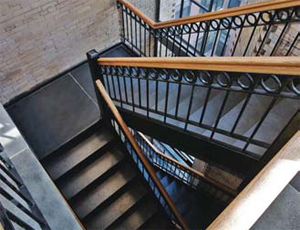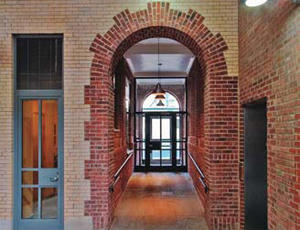A challenging $7 million project to renovate and restore The Emerson, in Manhattan’s Clinton Urban Renewal Area, proved more difficult than expected.
The Emerson was constructed in 1915 as a model tenement building, providing safe and healthy apartments for families and the working poor. William Emerson, an architect and prominent proponent of housing reform, designed the seven-story building with 63 apartments, a grocery, public showers and other social services.


Plans to demolish the dilapidated, vandalized and pigeon infested property at 53rd Street and Eleventh Avenue marshaled the building’s remaining tenants to organize a tenant association to save their homes.
The City of New York, which owned the property, approached the Clinton Housing Development Company (CHDC) in 1999 to develop a plan for rehabilitating the structure. CHDC decided to renovate and restore the structure to its original purpose as affordable housing.
CHDC was unable to raise enough money for the project through the Supportive Housing Loan Program and private investments from syndication of Low Income Housing Tax Credits. So the organization sought and won Historic Preservation Tax Credits for an additional $1.2 million in private investment.
The clean-out of the building removed 20-years worth of pigeon droppings two-ft deep in some places.
Two open stairways in the building’s inner courtyard, covered with corrugated panels, led to small balconies and the only entries for each apartment. Two months into the restoration of the steel and bluestone stairways, the team discovered that the structural steel needed to be replaced. “So we had to do a complete physical reconstruction to the inch,” explains Joe Restuccia, CHDC’s executive director.
New York-based Edelman Sultan Knox Wood / Architects designed glass and steel enclosures for the stairs to meet code, provide weatherproofing and daylight the apartment entryways.
The red bricks on the building’s street facades are laid up with struck horizontal joints and flush vertical joints. The facades were selectively repointed to preserve this treatment and cleaned.
Painstaking effort went into finding finishes, colors and materials that matched the original. Over 140 custom double-pane windows matching the original configuration and detailing were installed. The terra-cotta cornice between the first and second floors was also restored.
The apartments were gutted and reconfigured into 33 studio, one and two bedroom apartments with multiple windows in each room.
“We never expected the project to be as difficult as it was,” Restuccia says. “Perseverance wins the day in these types of projects. We literally started in 2000 and the building was not fully occupied until 2008. It was probably three times the work of a normal project.”
Key Players
Sponsor: New York City Department of Housing and Preservation, New York
Owner: Clinton Housing Development Company, New York
Architect: Edelman Sultan Knox Wood / Architects LLP, New York
Contractor: Mega Contracting, Astoria
M/E/P: Abraham Joselow, P.C., New York
Structural Engineer: Robert Silman Associates, PC., New York
Historic Consultant: Higgins Quasebarth & Partners, New York

Post a comment to this article
Report Abusive Comment